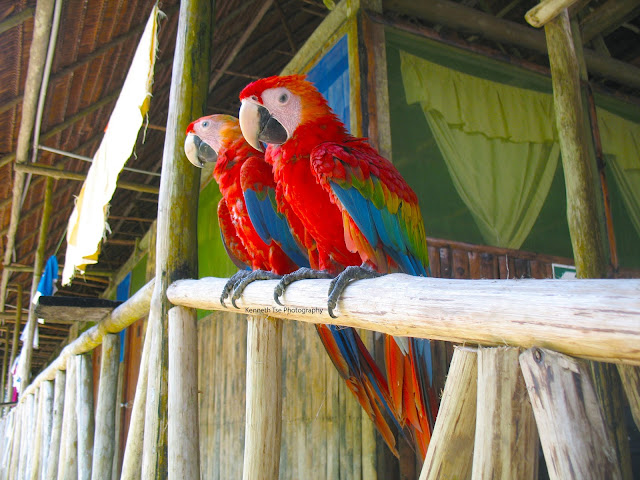After breakfast, we walked a block over to the Otorongo Expedition office and settled our balance. There was a hand drawn map of the Peruvian Amazon with some of the fauna we hope to see in the coming days.
We finally met Michael at the office. He came straight from the airport. He's been jet setting since mid-July on a crazy fishing trip. Here's our group before departure - from left Ben, me, Joy, Josh, George and Michael.
We took the motorbikes to the marina. All the luggage and gear were quickly loaded at the back of our covered transport boat. Everyone was at various level of excitement.
On our way to the lodge, which requires a 2h boat ride downstream from Iquitos, we stopped at a local farm that produces rum.
Juice extraction machine that has been passed on for 3 generations.
Joy and I were the workhorses.
Amazonian distillary.
Rum tasting
A view of the Amazon and our transport boat. Even this far upstream in the Amazon drainage, the river is huge!
Everyone carefully walking down the wooden stairs after a rum tasting. Some may had more than others...
We finally arrived at the lodge.
We were greeted by pet parrots. These green parrots learned a song that sounds like human laugh "jajajajaja!"
Pet scarlet macaws that have their wing feathers clipped but free to roam the grounds. We usually woke up at 6am by their morning squawks.
All of us in front of the dining building.
Josh and Joy couldn't wait to start.
But I was looking forward to lunch first.
After lunch, everyone got their gear ready and we were off to fish in small aluminum boats (which they call canoes)! With only a little less than 3 hours before dusk, we fished in the creek where the lodge was located.
I was fishing solo with my guide Yamil. Although I don't know a word in Spanish and Yamil doesn't know a word in English, we used hand signals on the first day. Later on, I would pick up a word here and there and we would have some sort of broken Spanglish conversation.
Fishing a bait on bottom was the best way to catch piranha and small catfish. They came quickly.
Serrasalmus rhombeus - Species #580 (Red eye and thick black margin on the tail ID this as S. rhombeus)
Once in a while, you would hear Pacu make loud splashes on the surface. Yamil told me to plop the bait on the surface because the Pacu are attracted to fruits and other baits that falls into the water. We were successful in catching one.
Pirapitinga (Piaractus brachypomus) - Species #581
Splashing the rod tip on the surface of the water would draw attention to fish, especially Red Piranha. Yamil said "muy aggressivo".
Red Piranha (Pygocentrus nattereri) - Species #582
If your bait sat on bottom, there were many of these little catfishes...almost too many. Yamil said these are "muy aggressivo". That's his way of telling me to watch out for their spines. These little catfish are very agile and it doesn't take much to poke you if you are not careful.
Bloch's Catfish (Pimelodus blochii) - Species #583
Bigger Red Piranha are less spotted but get much, much thicker.
Fishing the middle of the creek channel, I picked up a cool catfish.
Sorubim maniradii - Species #584 (could be Sorubim lima as well...can't really tell unless we count gill rakers, but the black stripe seems diffuse to me)
Anthony, the lodge owner, came by and tossed us a palm weevil larvae. They are awesome bait that we affectionately call "sweet juicy grub". Using chunks of the larvae near a log jam, I caught some Piranha until something different tug on the line with a bit more force.
Cynodon gibbus - Species #585 (little cousin to the well known Payara. The Payara has much shorter anal fin)
A new catfish species also came on the grub. It has a dorsal spine that can angle forward.
Ageneiosus ucayalensis - Species #586
The last fish of the afternoon was a good size S. rhombeus. The adults loses the spots and get much thicker with profiles and girth much like Red Piranha.
At dinner, we were served some of the palm weevil. They were roasted and tasted awesome!
We had breaded Arapaima fillets for the main course. Anthony raise his own Arapaima. He would collect juveniles and grown them in his own pond until around 50lbs in size. Arapaima is extremely tasty!
After dinner, we discussed plans for the coming few days. At the end, we decided to travel 2 hours from the lodge to access a couple of lakes closer to Iquitos. Due to the distance, we would set up primitive camp on the bank of a tributary river to the Amazon and sleep on the edge of the jungle for 1 or 2 nights, depending on the fishing and our wishes to fish more or less days.
Everyone were pretty tired from the day of travel and fishing and went to bed early. In the jungle, you don't stay up too late after sundown.




























No comments:
Post a Comment